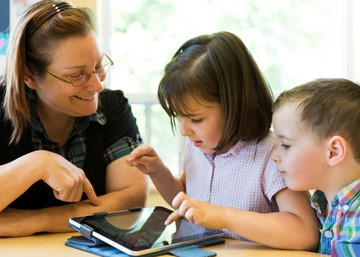In order for you to effectively integrate technology in early childhood education and develop ICT capability in the learning environment, it is essential to understand the key elements of learning theories that underpin the ICT support learning.
Learning with ICT includes:
- Constructivism;
- Social constructivism;
- Situativity;
- Brain-based ideas;
- Metacognition and;
- Affective aspects.
Theorist such as Kennewell (2004) suggests that there are three types of knowledge – knowing that, knowing how and knowing why. Whereas ‘knowing that’ refers to factual knowledge, ‘knowing how’ refers to skills and the last one concerns the element of understanding of which there is a high emphasis on.
He points out that all are essential and that all school curricula are based on them. As a result, as a teacher, your understanding of ICT integration should follow suit.
Constructivism theories were developed at the same time as behaviourism by such theorists as Jean Piaget. However, though similar the key ideas revolved around the concept that the “development of schematic structures in the mind which constituted understanding” (Kennewell, 2004, p. 90).
A key part of this theory is part that emphasises the importance of children learning while reflecting on experiences. Reflection plays a significant role in the learning of ICT capability for without it is unlikely that experiences will have any effect on mental structures.
For this reason, it is important that you provide opportunities for children to reflect on their experiences at different stages of their work. This will involve you to continually plan and monitor their actions carried out during tasks.

Social constructivism focuses mainly on the individual mind and therefore has a tremendous amount to do with cognitive development.
This type of theory encompasses key concepts such as you as the teacher considering the learning environment in addition to discussing how collaboration is paramount to learning.
The collaboration of children on ICT tasks has a powerful role to play which is why it forms the basis for many approaches to using ICT in the classroom today.
Higher order skill development is a significant component of what constitutes as ICT capability. The skills which it encompasses includes monitoring, evaluating, selection and the control over processes – all of which are metacognitive in nature. For ICT capability within children to occur they need to:
- Be aware of their own knowledge and ICT techniques and processes;
- Be aware of the opportunities and limitations offered by the possible use of ICT techniques and processes and;
- Have the ability to regulate their own actions in the application of that knowledge.
‘Knowing what you know’ is important because “knowing how well they are likely to perform in a situation will affect the way students approach a task and how successfully they are likely to be” (Kennewell, 2004, p. 93).
This feeling of self-efficacy will enable them to choose to do something and to take the risk of being wrong. Additionally, it will help them make realistic assessments about what they can learn.
Problem solving skills are dependent on metacognitive knowledge as it calls on what you know. These skills are essential for inquiry based lessons that are based on authentic (real world) problems. We need children to become the problem solvers of the future.
The third part of the above focuses on “when, why and how children explore, plan, monitor, regulate and evaluate progress” (Kennewell, Parkinson, & Tanner, 2000, p. 47). It too is influenced by metacognitive knowledge.
Situativity refers to the theory that learning is of our participation in activities in various social settings where the knowledge gained is situated in the setting and therefore, a change in the setting means new learning.
Brain-based ideas is based on the claim that while we might use visual, auditory and kinaesthetic activity in learning, we each have a preference for which one is best for us to use. This has two main issues for you as teacher:
- How to accelerate learning by exploiting the full range of individual learners’ strength and;
- How to help learners improve their abilities in strategies that are naturally weak?
- (Kennewell, 2004, p. 93)
ICT can help accelerate learning through the use of multimedia presentations that comes with images, sound, and animation which is more effective than only oral/verbal exposition.
Finally, affective aspects refers to the degree that children are motivated by the activity that they are engaged in. This has a lot to do with their self-esteem which is improved in the technology-rich learning environment. Even the disaffected children may find an incentive to use ICT as it provides them with the potential and structure for action that they need on a continual basis (Kennewell, 2004) in addition to the fact that they do not realise that they are investing effort in learning. As Kennewell (2004) states “if disaffected children can gain success when ICT is used, an immediate positive assessment of their subject learning (not just their ICT capability) combined with appropriate praise may them encouragement to continue their effort” (p. 94).
To discover more of the benefits of technology in early childhood education, take an in depth look into our accredited online for teachers in early childhood education.

Children and Technology Learning
Children learn in different ways from birth all the way up. It can be from observation, exploring and interacting in a stimulating environment. The relationships in their lives will play a crucial role in this learning and typically children will learn to communicate, think and problem-solve within these environments that they live.
The above information highlighted how children and learning takes place when using technology. Learning with technology brings many advantages.
However, it is important that when thinking about children and learning with technology that you understand technology should always be viewed as a tool for learning and that the potential for effective learning with technologies lies with the people such as parents and teachers who use them.
Information and Communication Technology (ICT) in the early years setting yet, can be used for many different ways and purposes. Your child will in the end learn about and through ICT itself. For example, they will learn about ICT as they investigate what it can do, how it works and what it can be used for. On the other hand, they will learn through ICT when they use is as a tool for a purpose.
Children and learning with technologies normally occurs through digital play. In Mona Sakr’s book on digital play in early childhood, she explains that digital play observation can raise several questions but states that key factors in it such as creativity, curiosity and criticality are fundamental aspects to our approach to digital play. They are exactly what we as adults and teachers need to ensure is present in a digital playground as they are important factors in young child’s learning and development. This means that you as an adult are central in ensuring that children develop these 3Cs.
Learning with technologies for children is very similar to how they would learn with other mediums. According to Raising Children observing, listening, exploring, asking questions, experimenting and doing things that stimulate their senses is how children actively engage with their environment. ICT can help young children accomplish many of these aspects of their learning.
As children get older, ICT can continue to help them with:
- Language and communication;
- Space, place and environments;
- Health and physical fitness;
- Numeracy, literacy and handwriting and music.
Ultimately, as mentioned earlier it will be the responsibility of the adults in children’s lives who will play an important role in developing their technological literacy and ICT capability. Such aspects of their learning and development like creativity, critical thinking, curiosity and need to be considered the planned use of ICT if you are to help children benefit from their technological experiences.

Technology and Child Development
Why is technology an important area of children's development?
Our everyday life is filled with technology and, as an adult navigating the world, understanding this technology is essential. Screen time, cyber safety and health are all valid concerns from most parents. However, introducing your child to the wonders of learning with technology goes beyond simply handing them a tablet to explore.
Early childhood and technology
Early childhood education is filled with opportunities to take risks, build resilience, self-esteem, and exploration. This is all achieved by learning through play. Each experience offered to a child by parents and educators holistically contributes to their education and development.
Technology plays its part for children and learning, particularly in earlier years. This can be playing music, introducing sensory toys with lights, and cause and effect toys for babies.
What happens when I press this button? Oh! It makes a noise. Does it do it every time that I press this button?
And so, the investigation begins. Extending beyond the realm of a screen and into the realm of discovery.
For toddlers and pre-school children, learning with different technologies helps retain curiosity whilst providing them with opportunities to release energy. Remote control cars, use of torches, tablets, cameras, buttons and flaps amongst many other toys encourage children to be curious with their education.
Skill development
Different skills can be built when learning with technology, and it can be linked to many areas of learning. For example, using a camera when exploring the natural world can be further extended to include mathematics and research skills. This provides a stepping-stone, introducing the idea that questions can be answered using technology whilst also enabling children to be creative whilst taking photos.
This idea broadens as the child grows older, and they are introduced to different types of technology. What can they create on the computer using digital art programmes? What can they write, research, and read? Suddenly, learning with technologies becomes a lot more interesting.
Parent engagement and participation
Modern technology opens many doors when it comes to building relationships. The world becomes a much bigger place as communication platforms provide opportunities to see and speak to family members. Participating with your child through games, communication, story-telling and watching videos helps embed your relationships as you spend quality time together.
Using age-appropriate technology that also contributes to children and learning keeps education open and fun. For example, many games now provide opportunities to build and construct, problem solve, and build resilience as children learn to cope with losing. Through learning with these technologies, children are learning safely and securely, with independence and freedom.
Technology is an excellent addition for children and learning, both as a resource and an area of development. Learning with technology provides children with the tools to expand their knowledge base and explore different skillsets. As parents and educators, it is our duty to ensure the technologies used are safe and secure for children as we introduce new experiences for them that make learning fun.
How young children learn
When discussing children and learning it is important to realise that your child's relationship with you, your family members and other carers are the foundation of your child's learning and development. Children and learning and development is best when:
- Observing things, watching faces and responding to voices;
- listening to sounds, making sounds and singing;
- Exploring - for example, putting things in mouth, shaking things etc;
- Asking questions;
- Experimenting with textures, objects and materials;
- Doing things that stimulate all of her senses.
More Information about Children and Learning here:
Children and Learning about Sexuality
Harness Technology in Early Childhood Education - Take a deep look into how this online PD for early childhood educators supports children and learning with technologies in the early childhood learning environment today.